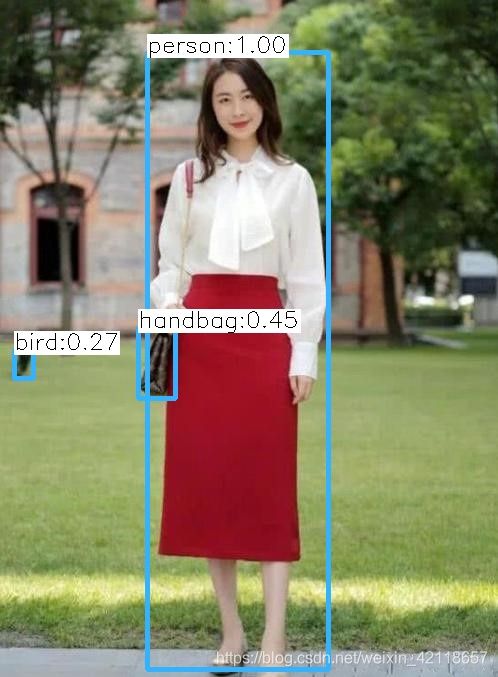python、C++ 中通过OpenCV的DNN模块使用YoloV4
目录
1 Python环境下调用
2 C++环境下调用(编写CMakeLists.txt文件)
2.1 OpenCV安装
2.2 程序编写
2.2.1 main.cpp
2.2.2 Detection.h
2.2.3 Detection.cpp
2.2.4 CMakeLists.txt
2.3 编译和测试
1 Python环境下调用
这个较为简单,唯一注意要点是安装的opencv-python版本要对,以下代码仅支持4.4.0.XX系列OpenCV版本,4.5.0版本OpenCV没有getUnconnectedOutLayersNames()这个属性。
完整代码如下:
import numpy as np
import time
import cv2
if cv2.__version__ != '4.4.0':
print("opencv版本不支持! 本程序语法仅支持4.4.0系列OpenCV")
LABELS = open("coco.names").read().strip().split("\n")
np.random.seed(666)
COLORS = np.random.randint(0, 255, size=(len(LABELS), 3), dtype="uint8")
# 导入 YOLO 配置和权重文件并加载网络:
net = cv2.dnn_DetectionModel('/home/ym/ym2021/yolov4.cfg', '/home/ym/ym2021/yolov4.weights')
# 获取 YOLO 未连接的输出图层
layer = net.getUnconnectedOutLayersNames()
image = cv2.imread('1.jpg')
# 获取图片尺寸
(H, W) = image.shape[:2]
# 从输入图像构造一个 blob,然后执行 YOLO 对象检测器的前向传递,给我们边界盒和相关概率
blob = cv2.dnn.blobFromImage(image, 1/255.0, (416, 416),
swapRB=True, crop=False)
net.setInput(blob)
start = time.time()
# 前向传递,获得信息
layerOutputs = net.forward(layer)
# 用于得出检测时间
end = time.time()
print("YOLO took {:.6f} seconds".format(end - start))
boxes = []
confidences = []
classIDs = []
# 循环提取每个输出层
for output in layerOutputs:
# 循环提取每个框
for detection in output:
# 提取当前目标的类 ID 和置信度
scores = detection[5:]
classID = np.argmax(scores)
confidence = scores[classID]
# 通过确保检测概率大于最小概率来过滤弱预测
if confidence > 0.5:
# 将边界框坐标相对于图像的大小进行缩放,YOLO 返回的是边界框的中心(x, y)坐标,
# 后面是边界框的宽度和高度
box = detection[0:4] * np.array([W, H, W, H])
(centerX, centerY, width, height) = box.astype("int")
# 转换出边框左上角坐标
x = int(centerX - (width / 2))
y = int(centerY - (height / 2))
# 更新边界框坐标、置信度和类 id 的列表
boxes.append([x, y, int(width), int(height)])
confidences.append(float(confidence))
classIDs.append(classID)
# 非最大值抑制,确定唯一边框
idxs = cv2.dnn.NMSBoxes(boxes, confidences, 0.5, 0.3)
# 确定每个对象至少有一个框存在
if len(idxs) > 0:
# 循环画出保存的边框
for i in idxs.flatten():
# 提取坐标和宽度
(x, y) = (boxes[i][0], boxes[i][1])
(w, h) = (boxes[i][2], boxes[i][3])
# 画出边框和标签
color = [int(c) for c in COLORS[classIDs[i]]]
cv2.rectangle(image, (x, y), (x + w, y + h), color, 1, lineType=cv2.LINE_AA)
text = "{}: {:.4f}".format(LABELS[classIDs[i]], confidences[i])
cv2.putText(image, text, (x, y - 5), cv2.FONT_HERSHEY_SIMPLEX,
0.5, color, 1, lineType=cv2.LINE_AA)
cv2.imshow("Tag", image)
cv2.waitKey(0)
2 C++环境下调用(编写CMakeLists.txt文件)
2.1 OpenCV安装
C++环境下编译安装OpenCV 4.5.1和OpenCV_Contrib库,参考我《ubuntu + oepncv + PCL + realsenseSDK + ROS + OpenVino开发环境搭建》https://blog.csdn.net/weixin_42118657/article/details/114527831
2.2 程序编写
程序结构如下:
- main.cpp
- Detection.cpp
- Detection.h
- CMakeLists.txt
- build文件夹
2.2.1 main.cpp
#include "Detection.h"
#include
using namespace std;
using namespace cv;
using namespace dnn;
void TestDetection()
{
string image_path = "/data/1.jpg";
string save_path = "result.jpg";
Mat img = imread(image_path);
cout << "width: " << img.cols << endl;
cout << "height: " << img.rows << endl;
Detection detection = Detection();
detection.Initialize(img.cols, img.rows);
detection.Detecting(img);
imwrite(save_path, detection.GetFrame());
return;
}
int main()
{
TestDetection();
return 0;
}
2.2.2 Detection.h
#pragma once
#ifndef __DETECTION_H__
#define __DETECTION_H__
#include
#include
#include
#include
#include
#include
#include
using namespace std;
using namespace cv;
using namespace dnn;
class Detection
{
public:
//构造、析构函数
Detection();
~Detection();
//初始化函数
void Initialize(int width, int height);
//读取网络模型
void ReadModel();
//行人与车辆检测
bool Detecting(Mat frame);
//获取网络输出层名称
vector GetOutputsNames();
//对输出进行处理,使用NMS选出最合适的框
void PostProcess();
//画检测结果
void Drawer();
//画出检测框和相关信息
void DrawBoxes(int classId, float conf, int left, int top, int right, int bottom);
//获取Mat对象
Mat GetFrame();
//获取图像宽度
int GetResWidth();
//获取图像高度
int GetResHeight();
private:
//图像属性
int m_width; //图像宽度
int m_height; //图像高度
//网络处理相关
Net m_model; //网络模型
Mat m_frame; //每一帧
Mat m_blob; //从每一帧创建一个4D的blob用于网络输入
vector m_outs; //网络输出
vector m_confs; //置信度
vector m_boxes; //检测框左上角坐标、宽、高
vector m_classIds; //类别id
vector m_perfIndx; //非极大阈值处理后边界框的下标
//检测超参数
int m_inpWidth; //网络输入图像宽度
int m_inpHeight; //网络输入图像高度
float m_confThro; //置信度阈值
float m_NMSThro; //NMS非极大抑制阈值
vector m_classes; //类别名称
private:
//内存释放
void Dump();
};
#endif 2.2.3 Detection.cpp
#include "Detection.h"
using namespace cv;
using namespace dnn;
//构造函数,成员变量初始化
Detection::Detection()
{
//图像属性
m_width = 0;
m_height = 0;
m_inpWidth = 416;
m_inpHeight = 416;
//其他成员变量
m_confThro = 0.25;
m_NMSThro = 0.4;
//网络模型加载
ReadModel();
}
//析构函数
Detection::~Detection()
{
Dump();
}
//内存释放
void Detection::Dump()
{
//网络输出相关清零
m_outs.clear();
m_boxes.clear();
m_confs.clear();
m_classIds.clear();
m_perfIndx.clear();
}
//初始化函数
void Detection::Initialize(int width, int height)
{
//图像属性
m_width = width;
m_height = height;
}
//读取网络模型和类别
void Detection::ReadModel()
{
string classesFile = "/data/coco.names";
String modelConfig = "/data/yolov4.cfg";
String modelWeights = "/data/yolov4.weights";
//加载类别名
ifstream ifs(classesFile.c_str());
string line;
while (getline(ifs, line))
m_classes.push_back(line);
//加载网络模型
m_model = readNetFromDarknet(modelConfig, modelWeights);
m_model.setPreferableBackend(DNN_BACKEND_OPENCV);
m_model.setPreferableTarget(DNN_TARGET_OPENCL);
}
//行人与车辆检测
bool Detection::Detecting(Mat frame)
{
m_frame = frame.clone();
//创建4D的blob用于网络输入
blobFromImage(m_frame, m_blob, 1 / 255.0, Size(m_inpWidth, m_inpHeight), Scalar(0, 0, 0), true, false);
//设置网络输入
m_model.setInput(m_blob);
//前向预测得到网络输出,forward需要知道输出层,这里用了一个函数找到输出层
m_model.forward(m_outs, GetOutputsNames());
//使用非极大抑制NMS删除置信度较低的边界框
PostProcess();
//画检测框
Drawer();
return true;
}
//获取网络输出层名称
vector Detection::GetOutputsNames()
{
static vector names;
if (names.empty())
{
//得到输出层索引号
vector outLayers = m_model.getUnconnectedOutLayers();
//得到网络中所有层名称
vector layersNames = m_model.getLayerNames();
//获取输出层名称
names.resize(outLayers.size());
for (int i = 0; i < outLayers.size(); ++i)
names[i] = layersNames[outLayers[i] - 1];
}
return names;
}
//使用非极大抑制NMS去除置信度较低的边界框
void Detection::PostProcess()
{
for (int num = 0; num < m_outs.size(); num++)
{
Point Position;
double confidence;
//得到每个输出的数据
float *data = (float *)m_outs[num].data;
for (int j = 0; j < m_outs[num].rows; j++, data += m_outs[num].cols)
{
//得到该输出的所有类别的
Mat scores = m_outs[num].row(j).colRange(5, m_outs[num].cols);
//获取最大置信度对应的值和位置
minMaxLoc(scores, 0, &confidence, 0, &Position);
//对置信度大于阈值的边界框进行相关计算和保存
if (confidence > m_confThro)
{
//data[0],data[1],data[2],data[3]都是相对于原图像的比例
int centerX = (int)(data[0] * m_width);
int centerY = (int)(data[1] * m_height);
int width = (int)(data[2] * m_width);
int height = (int)(data[3] * m_height);
int left = centerX - width / 2;
int top = centerY - height / 2;
//保存信息
m_classIds.push_back(Position.x);
m_confs.push_back((float)confidence);
m_boxes.push_back(Rect(left, top, width, height));
}
}
}
//非极大值抑制,以消除具有较低置信度的冗余重叠框
NMSBoxes(m_boxes, m_confs, m_confThro, m_NMSThro, m_perfIndx);
}
//画出检测结果
void Detection::Drawer()
{
//获取所有最佳检测框信息
for (int i = 0; i < m_perfIndx.size(); i++)
{
int idx = m_perfIndx[i];
Rect box = m_boxes[idx];
DrawBoxes(m_classIds[idx], m_confs[idx], box.x, box.y,
box.x + box.width, box.y + box.height);
}
}
//画出检测框和相关信息
void Detection::DrawBoxes(int classId, float conf, int left, int top, int right, int bottom)
{
//画检测框
rectangle(m_frame, Point(left, top), Point(right, bottom), Scalar(255, 178, 50), 3);
//该检测框对应的类别和置信度
string label = format("%.2f", conf);
if (!m_classes.empty())
{
CV_Assert(classId < (int)m_classes.size());
label = m_classes[classId] + ":" + label;
}
//将标签显示在检测框顶部
int baseLine;
Size labelSize = getTextSize(label, FONT_HERSHEY_SIMPLEX, 0.5, 1, &baseLine);
top = max(top, labelSize.height);
rectangle(m_frame, Point(left, top - round(1.5 * labelSize.height)), Point(left + round(1.5 * labelSize.width), top + baseLine), Scalar(255, 255, 255), FILLED);
putText(m_frame, label, Point(left, top), FONT_HERSHEY_SIMPLEX, 0.75, Scalar(0, 0, 0), 1);
}
//获取Mat对象
Mat Detection::GetFrame()
{
return m_frame;
}
//获取结果图像宽度
int Detection::GetResWidth()
{
return m_width;
}
//获取结果图像高度
int Detection::GetResHeight()
{
return m_height;
}
2.2.4 CMakeLists.txt
cmake_minimum_required(VERSION 3.10)
project(yolo4_test)
set(CMAKE_CXX_STANDARD 11)
# Add block directories
set(DETECTION Detection.cpp)
add_executable(yolo4_test main.cpp ${DETECTION})
#寻找opencv库
find_package(OpenCV REQUIRED)
#添加头文件
include_directories(${OpenCV_INCLUDE_DIRS})
#链接Opencv库
target_link_libraries(yolo4_test ${OpenCV_LIBS} )
2.3 编译和测试
- cd 到源码目录
- mkdir build
- cd build
- cmake ..
- make
- ./yolo4_test(运行在build文件夹生成的可执行文件yolo4_test)
结果如下:
